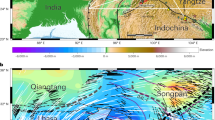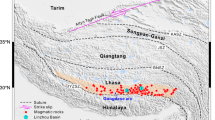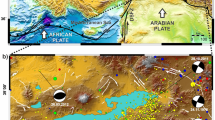Abstract
PALAEOMAGNETIC studies of late Cretaceous–early Tertiary red beds in southern Tibet indicate that they were magnetised at about 8°N and, therefore, that they subsequently moved north about 22° (ref. 1). Xiangyuan et al.1 collected 12 samples across the thickness of red beds which overlies an early late-Cretaceous stratum (Tsu mulong group) in Linzhou. Fossils of late Cretaceous marine fauna were found within the red bed itself, and Foraminifera (Lockhatia sp.) of early Tertiary age were found near an outcrop of the volcanic assembly that unconformably overlies the red beds. Three of their samples were tested for stability using alternating field demagnetisation with an applied field of 50–300 oersted. No obvious secondary magnetisation was found. These red beds are north of the Indus–Tsangpo suture2. Xiangyuan et al.1 compared the virtual geomagnetic pole from Tibet with those from rocks of the same age in India to show that this portion of Tibet was indeed not part of India in the late Cretaceous–early Tertiary. We show here that these new palaeomagnetic data also require about 2,500–3,500 km of north–south shortening in Asia since its collision with India.
This is a preview of subscription content, access via your institution
Access options
Subscribe to this journal
Receive 51 print issues and online access
$199.00 per year
only $3.90 per issue
Buy this article
- Purchase on SpringerLink
- Instant access to full article PDF
Prices may be subject to local taxes which are calculated during checkout
Similar content being viewed by others
References
Xiangyuan Zhu, Chung Liu, Sujuan Ye & Jinlu Lin Scientia Geol. Sinica 1, 44 (1977).
Gansser, A. in Himalaya: Science de la Terre 181 (Centre National de la Recherche, Paris, 1977).
Irving, E., Tanczyk, E. & Hastie, J. Catalogue of Palaeomagnetic Directions and Poles, Fourth Issue, Mesozoic Results 1954–1975 and Results from Seamounts (Dept Energy Mines and Res. Ottawa, 1976).
McElhinny, M. W. Paleomagnetism and Plate Tectonics (Cambridge University Press, 1973).
Irving, E. Nature 270, 304 (1977).
Norin, E. Geology 7 (Tryckeri Aktiebolaget Thule, Stockholm, 1946).
Cheng-fa Chang & Hsi-lan Cheng Scientia Sin. 16, 257 (1973).
Bonvalot, G. De Paris au Tonkin à Travers le Thibet inconnu (Hachette, Paris, 1892).
Hennig, A. Southern Tibet 5 (Kung. Boktryekeriet, P. A. Norstedt and Soner, Stockholm, 1975).
Molnar, P. & Burke, K. Geology 5, 461 (1977).
Molnar, P. & Tapponnier, P. Science 189, 419 (1975).
Author information
Authors and Affiliations
Rights and permissions
About this article
Cite this article
MOLNAR, P., CHEN, WP. Evidence of large Cainozoic crustal shortening of Asia. Nature 273, 218–220 (1978). https://doi.org/10.1038/273218a0
Received:
Accepted:
Issue date:
DOI: https://doi.org/10.1038/273218a0
This article is cited by
-
Vertical crustal motions across Eastern Tibet revealed by topography-dependent seismic tomography
Scientific Reports (2017)
-
Rayleigh wave phase velocity tomography and strong earthquake activity on the southeastern front of the Tibetan Plateau
Science China Earth Sciences (2014)
-
Anatomy of a continental subduction zone: The main mantle thrust in Northern Pakistan
Geologische Rundschau (1988)
-
Preliminary conclusions of the Royal Society and Academia Sinica 1985 geotraverse of Tibet
Nature (1986)
-
Drift tectonics — The fundamental rhythm of crustal drift and deformation
Geologische Rundschau (1985)



